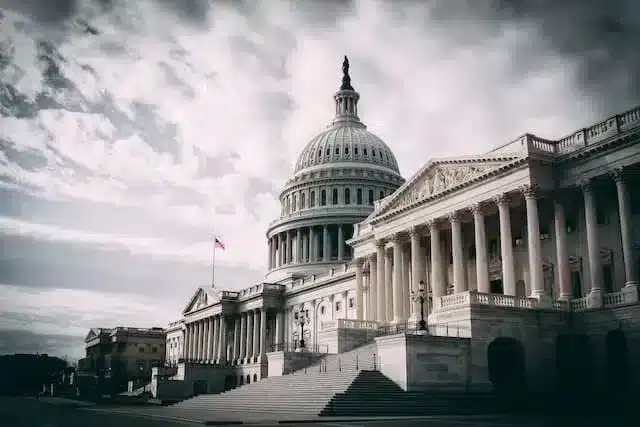
Update Aug. 16th, 2022: This article was originally published on August 10th, 2022, and has since been updated to reflect that the Inflation Reduction Act has since officially passed in the House and is now law.
On Sunday, August 7th, 2022, the senate approved a landmark $733 billion bill aimed at lowering inflation, boosting domestic manufacturing, and, most importantly, reducing carbon emissions by about 40% by 2030. The bill was then signed into law by President Joe Biden on August 16th, 2022. As we in the renewable energy sector know, this is nothing but good news for the solar, storage, and electric vehicle (EV) industries.
Here’s everything you need to know about the ambitious Inflation Reduction Act and what it means for the solar industry moving forward.
The History of the Inflation Reduction Act
Ever since Joe Biden became president, he has made it clear that he has ambitious plans for the renewable energy sector and infrastructure. Unfortunately, the current state of the Senate has made it very difficult to pass anything remarkable on either front, leaving the country in much the same position as it was in the early days of the Biden Administration.
In November 2021, a spin-off of the American Jobs Plan of March 2021 called the Build Back Better Act was passed in the House of Representatives. This bill, which would have cost about $1.7 trillion, aimed to improve social, infrastructural, and environmental programs through investment while also providing relief for those most affected by the COVID-19 pandemic.
President Biden’s original proposal, the Build Back Better Plan, was seen as extremely ambitious by many and therefore was split up into three separate parts. The American Rescue Plan aimed to provide relief for the COVID-19 pandemic passed, while the American Jobs Plan (AJP) and the American Families Plan (AFP) were proposed, with parts being diverted and passed in other bills. What remained was forged together into what we all know as the Build Back Better Act.
This Act came close to passing in the Senate but was ultimately unable to gain the support of Joe Manchin of West Virginia and Kyrsten Sinema of Arizona, who had concerns over its size, leaving the bill up for negotiations.
Ultimately, an agreement between Manchin and Senate Majority Leader Chuck Schumer resulted in the contents of the bill being reduced, resulting in today’s Inflation Reduction Act. Now, all that remains is for the bill to pass in the House.
What’s in the Inflation Reduction Act?
The Inflation Reduction Act aims to curb inflation by reducing the deficit, investing in domestic energy production while promoting clean energy solutions, and finally lowering the cost of prescription drugs. With such sweeping improvements, this bill is seen as one of the most ambitious climate bills in the history of the United States.
While this bill also focuses on lowering inflation, reducing the tax gap, and reducing the deficit by an estimated $102 billion over the next nine years, most of the talk surrounds the $369 billion set aside for investments in curbing greenhouse gas emissions through the promotion of clean energy in order to hit the goal of reducing emissions by 40% by 2030. Here are all the renewable energy aspects of the Inflation Reduction Act.
- Billions of dollars in tax credits and grants for every aspect of decarbonizing the economy and country, from using clean energy sources to reducing emissions from manufacturing, procuring American-made clean technologies, and supporting the deployment of clean energy in disadvantaged communities.
- $60 billion for communities most affected by climate change. There will also be additional “climate resiliency funding” set aside for Native Americans in the millions of dollars.
- Federal support for decarbonizing all sectors of the economy through investment in “innovative climate solutions.”
- 10 years of consumer tax credits to make homes energy efficient and run on clean energy, making solar photovoltaics, solar thermal systems, HVACs, etc. more affordable for all. This includes returning the solar Investment Tax Credit (ITC) benefits back up to 30% for another 10 years and adding an additional 30% credit for storage systems, including standalone solar storage.
- A $4,000 tax credit for purchasing a used clean vehicle and up to $7,500 towards a new clean vehicle.
- Tax credits to encourage and accelerate the domestic manufacturing of renewable technologies such as solar panels, solar and electric vehicle batteries, wind turbines, etc., with $10 billion invested in building more manufacturing facilities for these materials.
- An investment of $2 billion for National Labs to research new clean energy technologies.
As a whole, this bill takes a sweeping approach to both reducing emissions while encouraging clean energy technology in every aspect of American life, from incentivizing the economy to adopt renewable energy as a baseline to providing the American people with the means to decarbonize their own homes and lives without breaking the bank.
How the Inflation Reduction Act will Impact the Solar Industry
With so much above in favor of the growth of the solar industry, we could simply say that this bill will be great for solar energy industries as a whole and call it a day, but let’s take a closer look at the most important changes we will begin to see as this bill comes into effect.
An overall boost in solar jobs for contractors and solar companies
Included in the billions of dollars in tax credits, rebates, and grants for renewable energy and decarbonization is a refresh of the solar Investment Tax Credit. While solar salespeople won’t be able to capitalize on the urgency created by the ITC stepping down and eventually hitting a permanent 0% for residential and 10% for commercial installs in the next few years, they can now bank on the fact that so many more people will once again be able to afford to look into solar PV and energy storage options for their homes.
Solar companies can definitely expect an increase in quote requests and installation bookings in the coming months, so make sure you’re prepared!
More electric vehicles on the roads
Tax credits supporting the adoption of electric vehicles will help to “greenify” our commutes more than we’ve ever seen in the history of the automobile. Making the price point of EVs closer to that of your average gas guzzler will do so much to help people who couldn’t previously afford electric vehicles get their dream cars.
Pair these credits with the credits gained by installing solar and electrifying homes, and we’ll start seeing an influx of people whose entire lives are now powered with energy from the sun.
More domestic solar and storage manufacturing jobs
As we’ve seen in the last two years, our supply chain can sometimes be fragile, and relying on foreign imports can often be risky. Incentivizing companies to start manufacturing their renewable materials on American soil not only removes the risk we see from imports but also creates more jobs as a whole.
More materials available means less waiting for shipments from suppliers, and ultimately, solar companies should be able to fit more installs into their schedules with a shorter backlog.
Increasing the number of homes with full solar, storage, and EV systems
As we mentioned earlier, many people will now be able to afford to power their whole lives with renewable energy. There is an entire subset of the population currently living in buildings that rely on fossil fuel for power who couldn’t afford to electrify their homes or who thought the price tag was too high to do so. Now, with the billions in tax credits in incentives to claim, making the switch is suddenly more affordable and logical than ever.
Additionally, being able to “stack” incentives for solar PV, batteries, and EVs will see more people than ever running entirely renewable homes soon due to the increase in value and ROI they’ll see long-term. Solar businesses are about to get very busy.
An increase in standalone storage installations to improve the grid
With the addition of tax credits and incentives for more renewable-related technologies aside from solar panels, battery storage no longer needs to be directly tied to a solar system to qualify for a rebate or credit, and with so many new credits available, benefits can now be stacked.
This will allow for more storage in other locations away from solar panels to support the grid and handle the influx of new solar energy being pumped into the grid as a result of even more tax credits and incentives.
In Closing
The passing of this bill means nothing but great things for both the renewable energy industry as well as for the climate as a whole. As solar professionals, now is the time to start planning for the biggest boom we’ve seen since the beginning of the solar industry. Are you ready?
Looking to scope, sell and complete more solar projects than ever? Solargraf is the most user-friendly, robust, and fully integrated solution on the market. Book your free demo today to learn more about growing your business with Solargraf.



 United States
United States Germany/Austria
Germany/Austria Brazil
Brazil Netherlands
Netherlands Japan
Japan